Inflating a bike tire looks like an easy fix until you get down to it. It is an easy task that you can do even from the most remote place if you know what to do precisely.
For that, count yourself lucky because this guide will brace you with excellent tips on how to pump a bike tire.
Table of Contents
1. Identify Your Valve
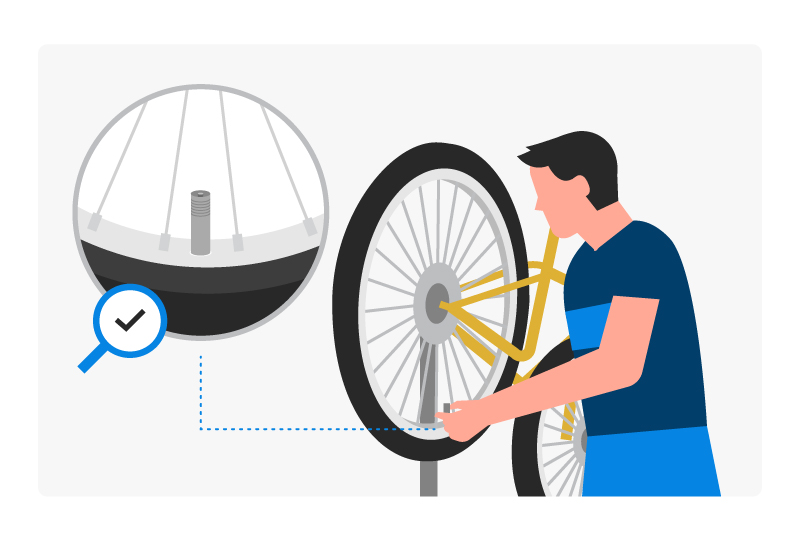
Although a bike tire valve is a small component, it arguably has a significant role in ensuring successful tire inflation. And, it requires more knowledge than you might assume.
For instance, you have to understand what valve befits your type of bike. Yes, different bikes use different valve systems. And, understanding what valve is suitable for your bike helps you to know the most compatible pump.
Here are the common types of bike valves.
Schrader
Most bikes, especially the inexpensive and older model bikes, have Schrader valves. But how do you identify it? Well, it has the same circumference from top to bottom. Apart from that, it has rubber wrapping.
Its width is greater than that of a Presta valve. It also has a threaded outer wall meant to accommodate a pump head or a cap. And the central pin acts as its check valve that works to open and close the air passage.
This pin, however, only allows air to flow in one direction. It is, therefore, necessary to exact pressure on it to permit inward airflow.
Presta
Newer bike models and high-end rides like the racing bikes use this type of valve. Unlike Schrader, it is slender and made of metal. You can only open its stem by unscrewing the locknut at the top.
What makes it different from a Schrader is that it has no check valve to close and open the air passage. The Presta instead closes and opens, depending on the pressure in the tube. This mechanism makes them easy to inflate because there’s no pin to overcome.
Woods
The Dunlop or Wood valve is commonly found in Asia and Europe. It looks like Presta, only that it is fatter.
2. Unscrew The Valve
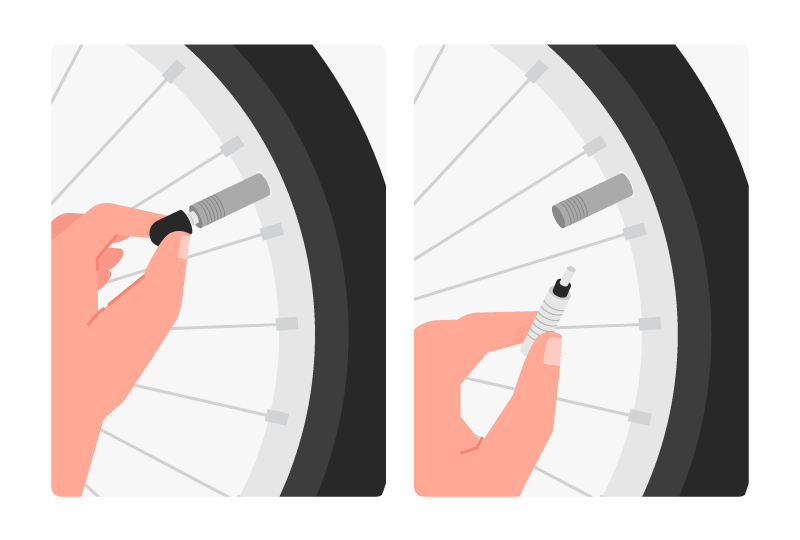
After determining the type of valve and have your pump ready, proceed and remove the cap on the valve. The caps are helpful in that they prevent debris and dirt from getting in the valve.
Unscrewing the cap on a Schrader valve is straightforward. However, the Presta valve demands that you unscrew the nut in addition to removing the cap. You’ll have to rotate the valve in an anticlockwise direction severally until you feel a stream of air coming out of it.
After that, keep the nut safe, because you’ll require it sometime later, to close the valve after pumping.
3. Prepare Your Bike Pump
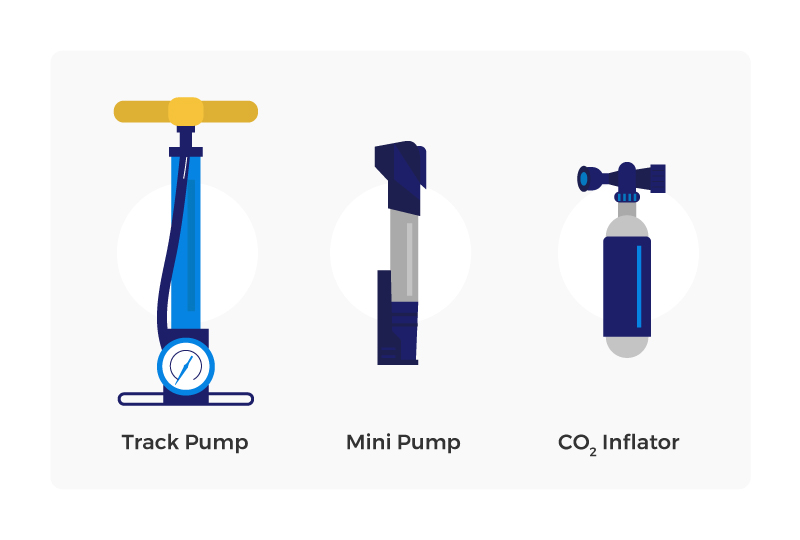
There are different types of pumps to inflate bike tires, each offering a different experience. You can choose any of the options to serve you if you want. They all work the same after all. Do you want to know your options?
Here are the types of inflating pumps.
Track Pump
A floor pump/track pump is the best bet to store in your garage. It should be your first option. This pump is an excellent choice because it has a higher capacity and can pump a bike until it exceeds the maximum PSI range (which is more than you need).
It has a long and flexible hose, gauge, and large chamber that offer the quick fix whenever you’d want. However, this inflator is not portable-meaning that you’ll only use it form home.
Mini Pump
For a trailside, a mini pump- also known as the hand pump, is the best go-to inflator. They are great fits for emergencies and long-distance rides because they are small, compact, and portable.
CO2 Inflator
If you get a flat out on the road and you are in a hurry, a CO2 is the quick fix. You can easily use it to inflate your tire with compressed carbon dioxide inside its cartridges.
4. Connect With The Pump
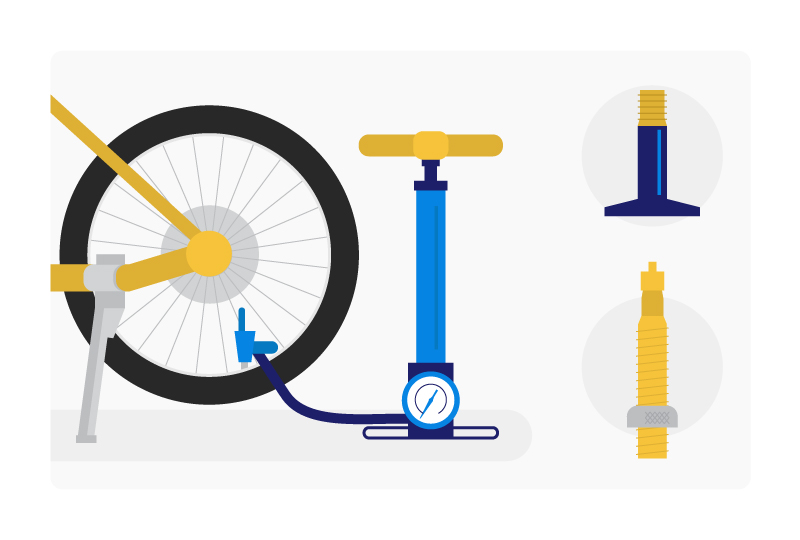
Luckily, modern pumps have connectors to both Presta and Schrader. You only have to ensure that you are using your pump in the right valve setting.
Start by firmly attaching the pump’s nozzle onto the valve. Lean forward and press firmly over the pump to make sure that it attaches.
Check whether the tire is filling or not. If not, it means that the air is coming out, and you have to re-adjust the pump head. If it’s fitting, go on and start pumping.
But then, inflating can feel like a mini-workout because it requires the use of your upper body, the core, and leg strength to pump.
5. Inflate To The Recommended PSI
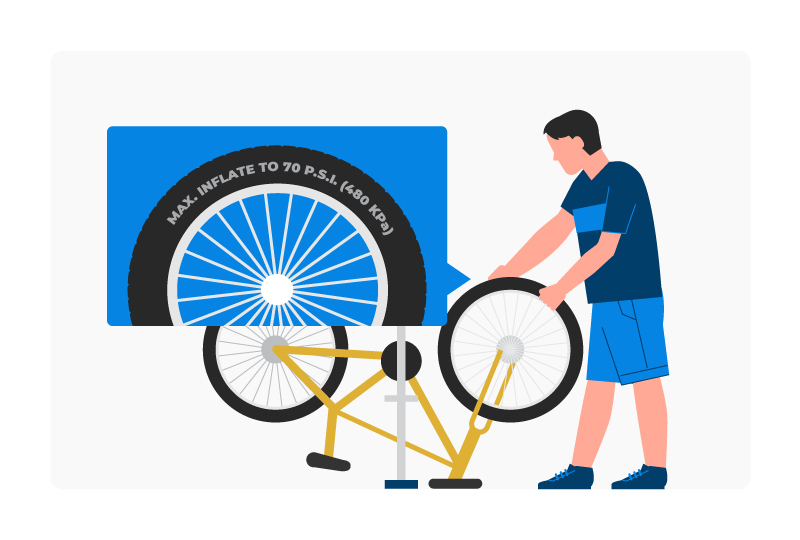
What’s the recommended pressure of your bicycle tire? You need to answer this question before you begin inflating your tire. Luckily, most of the tires have the pressure ranges on their sidewalls for you to check.
Why is it crucial to check the PSI range? It is vital for your safety, your bike’s longevity, and the riding experience. Pumping in the recommended pressure will prevent you from underinflating or overinflating.
You risk difficulty in braking, heat build-up in tires, faster rubber wear-out, and heat build-up in tires if you underinflate. Overinflating, on the other hand, can cause discomfort or explosions!
For this reason, if you have a road bike, your range is 80-120psi because such range favors speed over smooth surfaces. The range for mountain bikes, on the other hand, is 25-45psi because lower pressure helps such bicycles to beat te loose and bumpy terrain. However, hybrid rides require medium pressure levels of 40-80 psi.
After you determine the range, check the gauge on the pump for guidance and pump until you reach your desired pressure levels.
6. Screw The Valve
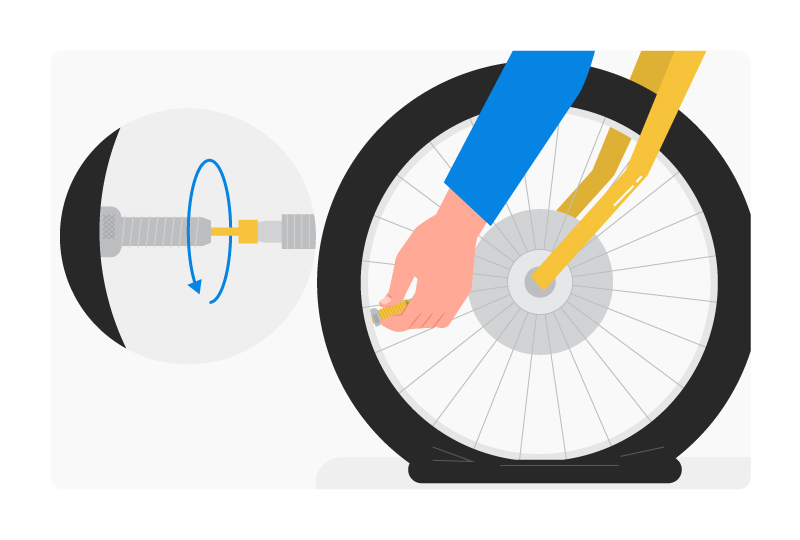
Screwing a Schrader valve is simple- put the cap back, and you are good to go. For a Presta valve, however, screw the lock nut back on until it is moving downwards. And, when its tight at the bottom, put the cap back on the nozzle.
Deflating The Tire
There you go, questioning why someone might want to deflate their tire. Well, one of the most common reasons is not paying attention to the PSI recommendations.
You’ll have to let out air from your tires if you over pump your tires. Relieving the tires will bar you from unpleasant rides or explosions. You can also deflate a tire if there’s a need to change it.
There are various ways of deflating a tire. They all depend on the type of valve on your tire. For instance, a Presta valve requires that you rotate the top part of the valve to open it. Then press on that top part until air escapes.
A Schrader demands that you use your fingernails or a small pointy tool to press on the springy pin in the middle of the valve until all the air escapes.
All in all, pay attention to how much air you want out because the longer you hold, the more it deflates.
How Often Should I Pump My Bike Tire?
How often you need to inflate your tires depends on how much you use your bike. General bike rules suggest that you pump after two weeks, whether you use it regularly or not. Plus, give your tires a quick squeeze whenever you hop on it. If it’s squishy – pump it.
Now that you have all the essential tips on how to pump a bicycle tire go ahead and hit the roads for a merry ride after successfully feeding your tires. See you on your next visit.

